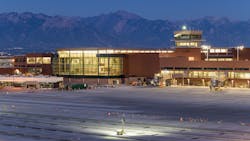SLC International Airport Achieves LEED Gold Certification, Celebrates 1-year Anniversary
The Salt Lake City Department of Airports (SLCDA) celebrates one year since opening The New SLC-Phase 1 — with the distinction of being the first new U.S. hub airport built in the 21st Century — while announcing LEED Gold certification from the U.S. Green Building Council.
The New SLC Airport was designed and built with a number of goals in mind: to build an airport that provides a flexible, right-sized design for the future that is more efficient, sustainable and maintains competitive costs. Additional goals were to build an airport that could withstand a major seismic event, provide more areas to plug in electronic devices and reflect the beauty of Utah — both inside and out. The New SLC has achieved its sustainability goal of LEED Gold certification for both the Terminal Redevelopment Program project and Concourse B-west.
“As two of the largest LEED v2009 gold certified airport terminal projects in the United States, the airport team faced the unique challenge of building on a large scale, while staying on-task and prioritizing health and sustainability,” said Lisa Stanley, director of technical services, USGBC. “I know just how dauting this task was and how much pre-planning was required to bring this project to where it is today, and congratulate all those involved.”
The airport achieved this certification through efforts involving emission reduction, waste minimization, water conservation and renewable energy implementation. Practicing sustainability began Day 1 of construction. Prior to the airport opening, 95 percent of construction waste was diverted from landfills and incinerators. Before opening day, airlines began to transition from diesel to electric ground support equipment. And the layout of The New SLC plays a substantial role in sustainability with a linear concourse configuration that reduces the time aircraft idle and taxi. “The airport recognizes the importance of reducing carbon emissions to mitigate our impact on global climate change,” said Bill Wyatt, executive director, Salt Lake City Department of Airports. “The former airport — which was a beloved part of our community — was inefficient when it came to sustainability efforts. Everything from the boiler system to the plumbing and electrical systems were beyond repair. What is really impressive is that the new airport uses less water and less electricity than the former facility.”
For a complete report on the airport’s sustainability goals and performance, go to slcairport.com/about-the-airport/community-and-environment.



